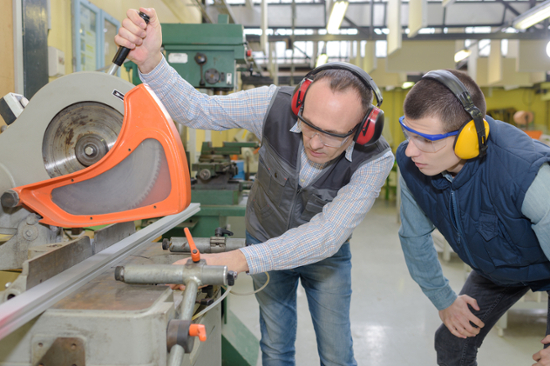
American workers who operate and maintain machinery suffer about 18,000 amputations, lacerations, crushing injuries, abrasions, and over 800 deaths per year. Investigators often find the equipment, such as power press brakes and forging machines, lack adequate safety mechanisms. These types of machine hazards continue to be among the most frequently cited by the Occupational Safety and Health Administration (OSHA).
To avoid the hazards of being caught in machinery and power tools, you should:
1 Learn the risks.
Always be aware you can get caught and pulled into machinery by belts, pulleys, gears, rotating shafts, and other moving parts. Machines can cause injuries and amputations when workers get pinned or crushed by a machine that vibrates or falls over, shocked or electrocuted by live electrical parts, or hit by material or debris from a machine.
2 Use machine guarding.
Never use any equipment unless a machine guard is in place. There are two primary safeguarding types: hard guards and safeguarding devices. Hard guards are a physical barrier between workers and moving parts. Whereas, safeguarding devices prevent accidental access to hazards. An example is a machine that requires two-handed controls so neither hand can enter the danger zone.
3 De-energize equipment.
Make sure all equipment is properly de-energized when not in use to keep the machine from accidentally starting. This is especially important when you are doing any kind of work on the equipment such as making repairs, changing accessories, or performing routine maintenance.
4 Keep your distance.
If you are not operating the equipment, stay away from it. Don’t wear loose clothing or anything that could get caught in moving parts and pull you in. Also, stay out of the swing radius of equipment because the operator may not be able to see you. If you must approach any equipment, make eye contact with the operator, and use clear hand signals to let the worker know you are approaching the machine.
5 Provide hands-on training.
Even the most well-designed safeguarding system cannot offer effective protection unless the worker knows how to use it and why. Ensure new operators and maintenance personnel receive safety training any time new or altered safeguards are put in use or when workers are assigned to new machines or operations. In addition to learning the hazards of each machine, workers need to know how the guards provide protection, under what circumstances the safeguards can be removed; when a lockout/tagout program is required; what personal protective equipment is needed, and who to contact if a safeguard is damaged, missing, or unable to provide protection.
For more information, visit OHSA’s machine guarding webpage, download the DWC’s machine guarding and lockout/tagout publications, or stream any of DWC’s free workplace safety videos. DWC safety training instructors are also available to provide customized training in machine guarding for your company by contacting safetytraining@tdi.texas.gov or 1-800-252-7031, option 2.
